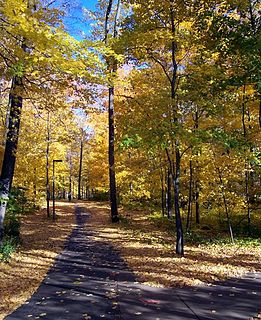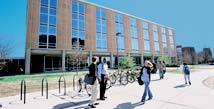| Saints' Rest | |
|---|---|
Saints Rest's former location on campus. | |
| General information | |
| Type | Dormitory |
| Architectural style | Eclectic |
| Location | Sacred Space Michigan State University |
| Named for | The Saints' Everlasting Rest (1650 hymnal) by Richard Baxter |
| Completed | 1856 |
| Demolished | 1876 (fire) Excavated in 2005 |
| Design and construction | |
| Architect | John Clough Holmes |
| Website | |
| Dig MSU | |
Saints' Rest was the second building erected on the campus of the Agricultural College of the State of Michigan (now Michigan State University). It was built in 1856 and served as the school's only dormitory until 1870, when Williams Hall was completed. Along with College Hall and a horse barn, it was one of three buildings completed when the college opened for classes in 1857.

Michigan State University (MSU) is a public research university in East Lansing, Michigan, United States. MSU was founded in 1855 and served as a model for land-grant universities later created under the Morrill Act of 1862. The university was founded as the Agricultural College of the State of Michigan, one of the country's first institutions of higher education to teach scientific agriculture. After the introduction of the Morrill Act, the college became coeducational and expanded its curriculum beyond agriculture. Today, MSU is one of the largest universities in the United States and has approximately 563,000 living alumni worldwide.

A dormitory is a building primarily providing sleeping and residential quarters for large numbers of people such as boarding school, high school, college or university students. In some countries, it can also refer to a room containing several beds accommodating people.

College Hall was the first building erected on the campus of the Agricultural College of the State of Michigan, and the first in the United States to be erected "for the teaching of scientific agriculture." Reputedly designed by John C. Holmes, it was built in 1856 and housed the school's classrooms, offices and laboratories, the school's library/museum, and a multifunction lecture hall/chapel. Along with Saints' Rest, and a horse barn, it was one of three buildings completed when the college opened for classes in 1857.
As the campus's only residence hall, the building had no official name. Students had a variety of nicknames for it including "the hall", "the boarding hall", "old hall", or "the house". It was only after the hall burned that it acquired the moniker "Saints' Rest", which came from the Puritan devotional The Saints' Everlasting Rest, written by Richard Baxter in 1650.

A nickname is a substitute for the proper name of a familiar person, place, or thing - commonly used for affection.

Richard Baxter was an English Puritan church leader, poet, hymnodist, theologian, and controversialist. Dean Stanley called him "the chief of English Protestant Schoolmen". After some false starts, he made his reputation by his ministry at Kidderminster, and at around the same time began a long and prolific career as theological writer. After the Restoration he refused preferment, while retaining a non-separatist Presbyterian approach, and became one of the most influential leaders of the Nonconformists, spending time in prison. His views on justification and sanctification are somewhat controversial and unconventional within the Calvinist tradition because his teachings seem, to some, to undermine salvation by faith, in that he emphasizes the necessity of repentance and faithfulness.
The hall burned down during the December 1876 vacation despite the efforts of the Lansing fire department, which made the run all the way from Lansing in only 45 minutes.

Lansing is the capital of the U.S. state of Michigan. It is mostly in Ingham County, although portions of the city extend west into Eaton County and north into Clinton County. The 2010 Census placed the city's population at 114,297, making it the fifth largest city in Michigan. The population of its Metropolitan Statistical Area (MSA) was 464,036, while the even larger Combined Statistical Area (CSA) population, which includes Shiawassee County, was 534,684. It was named the new state capital of Michigan in 1847, ten years after Michigan became a state.

A fire department or fire brigade, also known as a fire protection district, fire authority or fire and rescue service is an organization that primarily provides firefighting services for a specific geographic area. Fire departments are most commonly a public organization who operate within a municipality, county, state, nation, or special district. Private and specialist firefighting organizations also exist, such as those at airports.
On June 6, 2005, a team of Michigan State archeology professors and students began a six-week excavation on the site. The dig was part of MSU's 2005 sesquicentennial celebration.

Professor is an academic rank at universities and other post-secondary education and research institutions in most countries. Literally, professor derives from Latin as a "person who professes" being usually an expert in arts or sciences, a teacher of the highest rank.

A student is primarily a person enrolled in a school or other educational institution who attends classes in a course to attain the appropriate level of mastery of a subject under the guidance of an instructor and who devotes time outside class to do whatever activities the instructor assigns that are necessary either for class preparation or to submit evidence of progress towards that mastery. In the broader sense, a student is anyone who applies themselves to the intensive intellectual engagement with some matter necessary to master it as part of some practical affair in which such mastery is basic or decisive.

In archaeology, excavation is the exposure, processing and recording of archaeological remains. An excavation site or "dig" is a site being studied. Such a site excavation concerns itself with a specific archaeological site or a connected series of sites, and may be conducted over as little as several weeks to over a number of years.

















